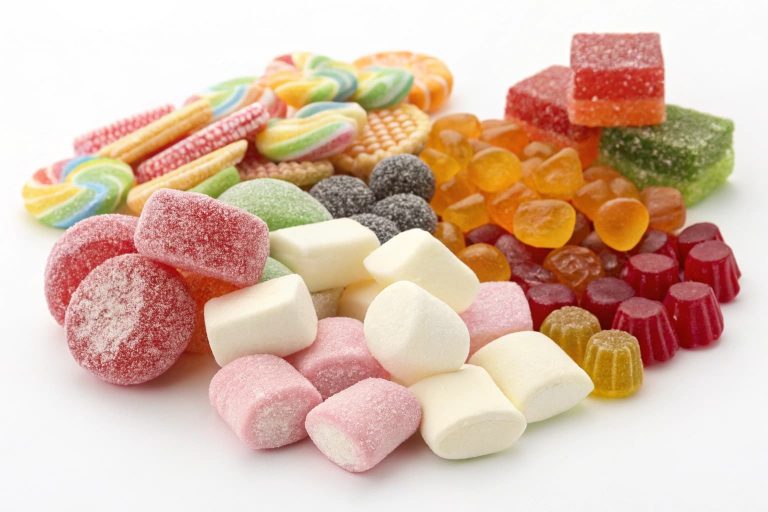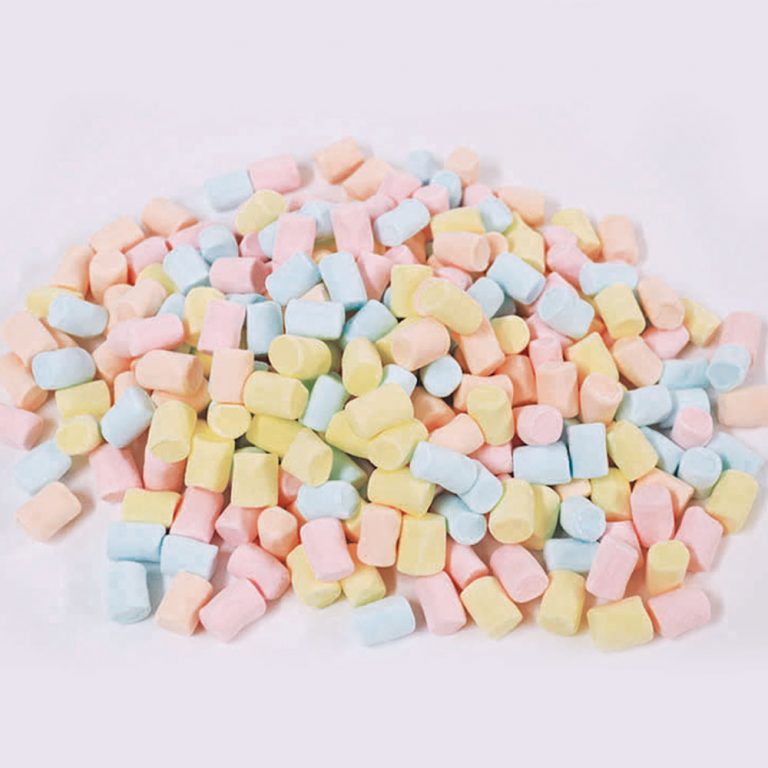One of the most exciting parts of my job is helping clients bring unique candy ideas to life. And when it comes to marshmallows, the possibilities often surprise people!
Yes, absolutely! Marshmallows are highly customizable in terms of flavor, color, and even shape. As a wholesale supplier, CSSweet specializes in working with businesses to create bespoke marshmallow products that perfectly match their brand, event theme, or specific market demand.
This opens up a world of creative possibilities beyond the standard white vanilla marshmallow. Let’s explore how each of these aspects – flavor, color, and shape – can be tailored to create something truly special.
How Can Marshmallow Flavors Be Customized?
Are you tired of plain vanilla? Wondering if you can get marshmallows that taste like your favorite fruit, or maybe something more exotic? I get this question a lot.
Marshmallow flavors can be extensively customized by incorporating a wide variety of food-grade flavorings, extracts, purees, or even powdered ingredients into the marshmallow base during production. This allows for an almost limitless range of taste profiles, from classic fruit flavors to more sophisticated or novelty options.
For businesses looking to create a unique product, custom flavoring is a powerful tool. Imagine a coffee-flavored marshmallow to complement a café’s offerings, or a spicy chili-mango marshmallow for a bold snack line. At CSSweet.com, we guide clients like Jeff through the flavor development process, ensuring the taste is not only appealing but also stable and consistent in the final product.
Methods of Flavor Customization
- Liquid Flavor Extracts & Essences:
- How it works: Concentrated natural or artificial flavorings are added to the marshmallow slurry before it sets.
- Common Flavors: Vanilla, strawberry, raspberry, lemon, orange, mint, chocolate, coffee, coconut.
- Advantages: Wide availability, cost-effective for many common flavors, easy to incorporate.
- Considerations: The flavor intensity needs to be carefully balanced. Some delicate flavors might be slightly altered by the marshmallow cooking process.
- Fruit Purees and Concentrates:
- How it works: Real fruit purees or concentrates are blended into the marshmallow base.
- Common Flavors: Strawberry, mango, passion fruit, blueberry, apple.
- Advantages: Provides a more natural and authentic fruit taste, can also contribute to color.
- Considerations: Can affect the marshmallow’s texture and moisture content if not properly formulated. May have a shorter shelf life for some purees.
- Powdered Ingredients:
- How it works: Finely ground powders are mixed in.
- Common Flavors: Cocoa powder (for chocolate), matcha green tea powder, instant coffee powder, spice powders (cinnamon, ginger).
- Advantages: Can deliver intense, specific flavors and sometimes interesting textural elements.
- Considerations: The powder must be fine enough not to create a gritty texture. Solubility and dispersion are key.
- Inclusions (Post-Extrusion or Depositing):
- How it works: Small pieces of ingredients are sometimes folded in or sprinkled on top after the marshmallow is formed.
- Examples: Mini chocolate chips, toasted coconut flakes, crushed nuts (allergen considerations are vital here).
- Advantages: Adds textural contrast and visual appeal along with flavor.
- Considerations: Not suitable for all marshmallow types; can complicate production.
- Infusions:
- How it works: Some ingredients (like vanilla beans or citrus zest) can be steeped in the syrup base to infuse their flavor before being strained out.
- Advantages: Can yield subtle, nuanced flavors.
- Considerations: More labor-intensive; may not be suitable for strong flavor profiles.
Developing Custom Flavors
The process for developing a custom marshmallow flavor typically involves:
- Briefing: Understanding the client’s desired flavor profile, target audience, and any specific ingredient preferences (e.g., all-natural).
- Formulation: Our R&D team experiments with different flavor sources and concentrations.
- Sampling: We provide samples for client approval. This is a critical step where Jeff, for instance, would evaluate the taste against his market’s expectations.
- Refinement: Based on feedback, we adjust the formulation until it’s perfect.
Here’s a table showing some popular custom flavor categories and examples:
| Flavor Category | Example Flavors | Target Market Ideas |
|---|---|---|
| Fruity | Strawberry, Raspberry, Mango, Passion Fruit, Lemon | Children’s snacks, summer promotions, beverage pairings |
| Indulgent | Chocolate, Salted Caramel, Coffee, Toasted Coconut | Dessert toppings, gourmet gifts, adult treats |
| Spiced | Cinnamon, Ginger, Cardamom, Chili | Holiday specials, ethnic food accompaniments, bold snacks |
| Floral/Herbal | Lavender, Rose, Mint, Matcha Green Tea | Premium/artisanal lines, tea pairings, unique gifts |
The ability to customize flavors allows businesses to differentiate their marshmallow products significantly in a competitive market, whether they are targeting customers in Latin America, Russia, or any other region.
How Can Marshmallow Colors Be Customized?
Beyond taste, the visual appeal of a marshmallow is huge. Can you get them in your brand colors, or perhaps a rainbow of hues?
Marshmallow colors are easily customized using food-grade colorants, which can be either natural or artificial. These colorants are added to the marshmallow mixture before it sets, allowing for a vast spectrum of vibrant or pastel shades to match specific branding, themes, or product concepts.
Color is a powerful marketing tool. For a purchasing manager like Jeff, being able to order marshmallows in specific Pantone colors to match a client’s brand identity, or in festive colors for seasonal promotions, is a significant advantage. At CSSweet.com, we offer extensive color customization options.
Types of Food Colorants Used
- Artificial Colors (Synthetic Dyes):
- Examples: FD&C Red No. 40, FD&C Yellow No. 5 (Tartrazine), FD&C Blue No. 1.
- Advantages: Produce very vibrant, stable, and consistent colors. Cost-effective. Wide range of shades achievable through blending.
- Considerations: Some consumers prefer to avoid artificial colors due to perceived health concerns. Labeling requirements vary by country (e.g., “Southampton Six” warnings in the EU for certain colors).
- Natural Colors (Derived from Plant, Animal, or Mineral Sources):
- Examples:
- Reds/Pinks: Beetroot extract, carmine (from cochineal insects – note: not vegetarian/vegan), anthocyanins (from berries).
- Yellows/Oranges: Turmeric, beta-carotene (from carrots), annatto.
- Greens: Chlorophyllin (from plants), spirulina extract.
- Blues: Spirulina extract (can be less stable), butterfly pea flower extract.
- Browns: Caramel color.
- Blacks: Vegetable carbon.
- Advantages: Appeal to consumers seeking “clean label” products.
- Considerations: Can be more expensive than artificial colors. May be less stable to heat, light, or pH changes, potentially leading to fading or color shifts. The range of vibrant shades, especially blues and greens, can be more limited or challenging to achieve. Some natural colors can impart a slight flavor.
- Examples:
Achieving Specific Colors
- Single Colors: Easily achieved by adding one colorant.
- Blended Colors: Multiple colorants can be mixed to create custom shades (e.g., yellow and blue to make green). This requires precise measurement and testing.
- Pantone Matching: For specific brand colors, we can work towards matching Pantone (PMS) references. This often involves careful blending and sample iterations to get as close as possible, considering the food-grade nature of the colorants.
- Multi-Colored Marshmallows:
- Swirls/Marbling: Different colored marshmallow mixtures can be gently swirled together before setting.
- Layered: Different colored layers can be deposited on top of each other.
- Striped: Achieved through specialized extrusion nozzles.
Factors Affecting Color Choice
- Target Market Preferences: Some markets have a strong preference for natural colors.
- Product Application: If the marshmallow will be exposed to harsh light or high heat (e.g., in baking), color stability is crucial.
- Cost: Natural colors can significantly impact the final product cost.
- Regulatory Requirements: Different countries have different rules about approved food colorants and labeling. We ensure compliance for export markets like Latin America and Russia.
The ability to customize marshmallow color is a key service we offer at CSSweet.com, allowing our B2B clients to create visually stunning products that stand out.
How Can Marshmallow Shapes Be Customized?
Standard cylindrical or cube marshmallows are fine, but what if you want something more imaginative? A star shape for a party, or your company logo as a marshmallow?
Marshmallow shapes can be customized primarily through two methods: extrusion with custom dies, or depositing into custom molds. This allows for a wide variety of shapes beyond simple cylinders or cubes, including stars, hearts, animals, logos, and other intricate designs, though complexity impacts feasibility and cost.
Custom shapes can transform a simple marshmallow into a unique promotional item, a themed party favor, or a signature component of a dessert. For brand owners, this offers an exciting way to reinforce brand identity. Jeff, as a purchasing manager, would appreciate this capability for clients looking for that extra “wow” factor.
Main Methods for Custom Shaping
- Extrusion with Custom Dies:
- How it works: The warm marshmallow mass is forced through a specially shaped opening (a die) and then cut to the desired length. This is how most standard cylindrical and some other relatively simple shapes are made.
- Custom Shapes Achievable: Stars, hearts, fluted cylinders, ovals, simple character outlines (if not too complex).
- Advantages: Relatively cost-effective for high-volume production of simpler custom shapes once the die is made. Continuous process.
- Considerations:
- Die Cost: Creating a custom die involves design and manufacturing costs, which are typically a one-time investment. This cost needs to be amortized over the order volume.
- Complexity Limits: Very intricate or detailed shapes with sharp internal angles or thin protrusions can be difficult or impossible to achieve consistently through extrusion. The marshmallow mixture’s consistency also plays a role.
- Definition: The “puffing” nature of marshmallows means extruded shapes might be slightly softer or less sharply defined than molded ones.
- Depositing into Custom Molds (Starch Mogul or Starchless Depositing):
- How it works (Starch Mogul):
- Impressions (cavities) in the desired custom shape are made in trays filled with food-grade starch.
- The liquid marshmallow mixture is deposited into these starch cavities.
- The marshmallows set in the starch, which also helps absorb excess moisture.
- Once set, the marshmallows are removed from the starch, and any adhering starch is brushed or blown off.
- How it works (Starchless Depositing):
- The marshmallow mixture is deposited into silicone or metal molds, or onto belts with pre-formed cavities. This method avoids the use of starch.
- Custom Shapes Achievable: Highly detailed and intricate 3D shapes, logos, characters, complex geometric forms.
- Advantages: Allows for much greater detail and precision in shape than extrusion. Can produce true 3D shapes.
- Considerations:
- Mold Cost: Custom molds (especially for silicone or metal) can be expensive to design and produce, particularly for complex designs requiring many cavities.
- Production Speed: Depositing can be a slower process than extrusion, especially for complex molds or if manual de-molding is required.
- Minimum Order Quantities (MOQs): Due to mold costs and setup, MOQs for custom molded marshmallows are often higher.
- How it works (Starch Mogul):
Factors Influencing Shape Customization Feasibility & Cost
| Factor | Impact on Custom Shape |
|---|---|
| Shape Complexity | More intricate shapes (sharp angles, thin parts, undercuts) increase mold/die cost and may limit the manufacturing method. |
| Size of Marshmallow | Very small or very large custom shapes can present challenges in handling and consistency. |
| Order Volume (MOQ) | Higher volumes help amortize the one-time mold/die costs, making custom shapes more economical per unit. |
| Material Properties | The specific marshmallow formulation can affect how well it holds a complex shape. |
| Desired Definition | Molded shapes generally offer sharper definition than extruded shapes. |
At CSSweet.com, our design and production teams work closely with clients to assess the feasibility of their desired custom shapes. We provide guidance on the best manufacturing method, potential design adjustments for optimal production, and transparent costings for any necessary tooling. This service is invaluable for clients wanting to create truly unique, customized marshmallow products for markets in China, Latin America, Russia, or anywhere else globally.
Conclusion
Yes, marshmallows are incredibly versatile! From unique flavors and vibrant colors to imaginative custom shapes, the possibilities for customization are vast, allowing businesses to create truly distinctive products.


